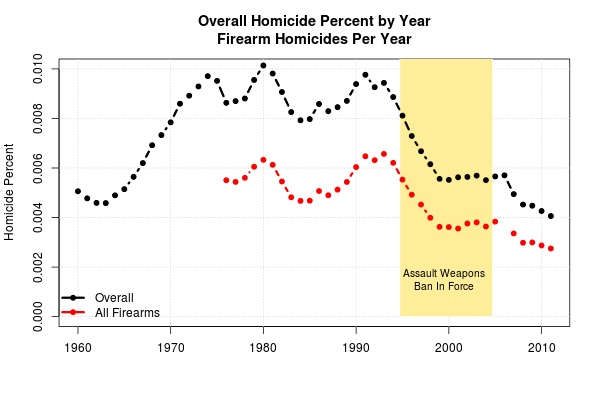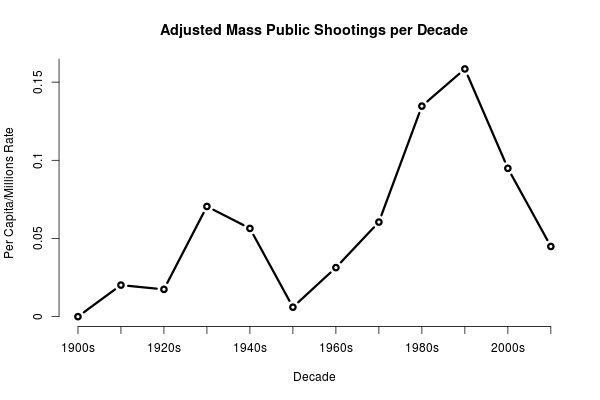 |
| Yes, he was arrested for "child endangerment." |
 |
| You go, Will! |
Lately, there was a massacre at an elementary school in Connecticut and people were naturally overwhelmed with grief and horror. A mentally ill young man off his meds stole a gun from his mother, killed his mother, several schoolchildren, a pair of teachers, and himself. The unsentimental might wonder why these people cannot start their spree at the other end of the string and kill themselves first, saving us all the agony. Naturally, the country immediately engaged in a vast debate on the subject of lunatic control.
I'm joking of course. In all the discussion on how this could have happened, relatively little was said about the young man who actually killed the children and much was made of the instrument he used to do it. One NYC TV news-repeater actually broke down live on camera at the scene and vented on the wickedness of the instrument. We don't like to actually, you know, blame the people who actually commit the crimes.
Example: Study after study has shown that Head Start (the Means) has no discernible impact on academic performance (the Ends) beyond the first few years. Yet opposition to the program is immediately touted as being against The Children™. The money spent on the program is money that cannot be spent on another, possibly effective program that actually does help; perhaps something like the école maternelle of France.
Example: An attack on the World Trade Center by Islamist radicals led to the imposition of a vast security bureaucracy and a set of new laws (the Means) which, had they been in effect at the time, would have done absolutely nothing to prevent the attack (the Ends).
Example: The 1963 Community Mental Health Act addressed the abuses of the state mental hospitals (the Ends) by ordering them closed and replaced by community health centers (the Means). This allowed the supporters of the bill to feel good about themselves; but few community health centers were built and the mentally ill were simply dumped on the streets in an act of mass compassion, thus creating the homeless problem that plagues us whenever a Republican is in office.
That Gun is Scary!
Now the same is true of the Assault Weapons Ban. This banned Scary-Looking Rifles (SLRs). It outlawed bayonet lugs, which might address all those people recently bayoneted to death, as well as collapsible buttstocks and flash suppressors. The one provision that made sense was a restriction on high capacity magazines, which might discourage those somehow unable to change out low capacity magazines quickly. If a rifle had any two of these features, it was banned.In the graph below, we see the association of this ban with homicides. At first blush, we might think the ban was effective, except that...
 |
| graph by Wm Briggs, Statistician to the Stars! |
- The homide rate continued to fall even after the ban expired.
- All homicides fell not just those committed with firearms.
- Most firearms used in homicides are handguns or shotguns, not rifles (incl. assault rifles)
- In fact, all violent crimes fell, including robbery, rape, etc.
- A Pareto breakdown of homicides by instrument gives us
But clearly the homicide rate decreased for some reason or combination of reasons. The big picture seems to tell us it was returning to normal after an exceptionally high rate during the 70s-90s. In fact, the 90s were a hump in violent crime in the UK as well as in the USA and, I believe, in France, as well. One possible reason was an age cohort of exceptional violence passing out of the optimal crime-making years. This decline was actually predicted in Strauss and Howe's book Generations.
- 60.2% handguns
- 13.1% knives
- 5.7% kicking and other uses of the human body
- 4.2% blunt objects
- 3.7% shotguns
- 3.6% rifles (including assault rifles)
Mass killings are a relatively thin slice of the total problem. Somehow, children killed as collateral damage in a drug gang drive-by seem less horrifying than many children killed with deliberate intent by mentally-disturbed individuals. (They shouldn't, but quantity and intent have their own quality.)
Now mass killings have actually been on the decline per capita:
But the rarity of airliner crashes vis a vis automobile crashes does not prevent us from efforts to make airliners safer. The same ought to be true of guns. Yet, airliners typically crash for failures of one or another system, not for successful execution of their Main Basic Function. (MBF is engineer-speak for "final cause.") The distress over mass shootings is not due to guns malfunctioning, but due to the shooter malfunctioning. A comparison can be made to the abuse of airliners by the 9/11 hijackers. There is very little that could have been done to the airliner to forestall that tragedy. The same is true of the abuse of guns by malfunctioning people.
This doesn't mean that nothing can or ought to be done. After the Kennedy assassination, the NRA supported the outlawing of mail-order purchase of guns. Back in Prohibition, the fully automatic rifle (machine gun, BAR) was outlawed as was the Thompson sub-machine gun, which fired a lighter, short-range pistol round and was favored by bootleggers and hijackers. In the Old Wild West, a cowboy's six-guns were often checked at the sheriff's office and returned to him when he left town. The Founding Fathers instituted an individual mandate that required every able-bodied white male who swore allegiance to the Republic to purchase a military grade weapon and report for militia drill, where their guns were registered. Blacks (both free and slave) and Tories were forbidden to bear arms.
The modern gun rights/control movement began May 2, 1967 when Bobby Seale and thirty Black Panthers carrying .357 Magnums, 12-gauge shotguns, and .45-caliber pistols climbed the capitol steps in Sacremento, and Bobby Seale "opened the door, and the radicals walked straight into the state’s most important government building, loaded guns in hand. No metal detectors stood in their way."
“Article number two of the constitutional amendments
provides you and me the right to own a rifle or a shotgun.” -- Malcolm X
John Wayne
Europeans are often horrified by the gun culture of the United States. Why, look at Denmark! Its murder rate is only 0.9. But Denmark holds 5.6 million people, most all of them Danes. This is slightly larger than Minnesota, which also has many Scandinavians... and a comparable murder rate of only 1.4. Across the border, Manitoba has a murder rate of 4.2 and Ontario 1.2. Canada actually has more guns per capita than the US, so it is not simply the availability of guns that matters. They were easier to get in the US in the 1950s, when the murder rate was low. Full disclosure: The Incomparable Marge toted a rifle when she was 12 and her dad took her hunting. This revelation caused her co-workers jaws to drop, but they were all NY or NJ people and not OK. The only guns TOF saw in his childhood home were a Japanese three-shot rifle and officer's pistol, both defanged, and a Navy Colt six shooter, Civil War era, but he learned the handling of a rifle in Boy Scouts and later in ROTC. And a lot of other kids had air rifles (BB guns) which they would let their friends try out in the woods. He also has a photograph somewhere showing his great-grandmother Mary McGovern Dieda Cantrel pointing a shotgun at the camera. It is not uncommon hereabouts to spot orange-clad hunters walking the back roads with a broke shotgun over their arm or a rifle over their shoulder. But these are not the folks who account for the local murder rate.Robert Heinlein famously coined the aphorism: An armed society is a polite society. This invited a rejoinder: Ask the Lebanese, who were at the time engaging in a brutal civil war. But of course politeness does not prohibit civil war, and Arabs are among the most polite of peoples. It simply means a level of courtesy in ordinary interactions. One's fights ought to be deliberate, not accidental. But here is the rub. As James Bowman notes
The Founding Fathers put the Second Amendment into the Constitution not because they thought guns would make people virtuous but because they thought Americans already were virtuous and would continue to be so and, therefore, that they could be trusted with lethal weapons.And Mary Dejevsky of the U.K. Independent, cited by Bowman elaborates:
A state that allows its citizens to carry arms is a state that is confident in its legality and unafraid of its people. Americans do not often defend their attitude to guns in this way, but if they did, they might be better understood.But this might no longer be true. For example, NYC police recently found a weapons cache and some hexamethylene triperoxide diamine high explosive in the apartment of an Occupy Wall Street activist and his society girl friend. A certain lack of trust was on display. So it may be that that people-government trust thingie is frayed a bit on both directions. There are folks trying to remake the entire fabric of society so that it conforms with their theory rather than with the Constitution; but
and no good intention is wasted as infernal paving material."The love of theory is the root of all evil." -- Wm. Briggs, Statistician to the Stars.
Mental Illness + Gun = Massacre
Everyone seems to agree that lunatics should not have guns; so background checks and waiting periods make sense. But it might also make sense to put as much emphasis on controlling the mentally ill in the equation as on controlling the gun.The mentally ill were "deinstitutionalized" in the 1960s and 70s by the Community Mental Health Act, which ordered the closing of the state mental institutions and their replacement by “community health centers.” But few of these centers were ever built and the ill were basically dumped on the streets in a fit of mass compassion, thus creating the homeless problem that plagues us every time there is a Republican in office. But just to emphasize the difficulties in any blanket action: those mental hospitals were closed for some very good reasons. Can you say "lobotomy"? (If so, you didn't have one.) Some upper middle class husbands put their wives away when they got uppity. So today, in a confusion of babies and bathwater, we don't put lunatics in asylums. We put our parents in asylums. I mean Retirement Communities.But just as the vast majority of guns are never used to commit crimes, the vast majority of the mentally ill do not commit crimes, either. It doesn't matter what the decision rule is. Some will be treated unjustly. In statistics, it is called alpha-risk and beta-risk, or Type I and Type II error.
What it comes down to is that there are no solutions; at least, no universal, iron-clad solutions. There will always be errors, gray zones, loopholes, exceptional cases, and the like. The decision to allow Joe to carry a weapon or forbid him will always produce Joes who should have been blocked but were not, and Joes who were unjustly deprived. And the same goes for their liberties as regards mental institutions. Some will be committed who should not have been; others will roam about who should have been. In a culture that insists that nothing should ever go wrong, random errors must the malevolent outcome of witchcraft, or something. Perhaps the Cold-heartedness or incipient Tyranny, depending on what floats your boat.
In closing, consider three instances.
 |
| Deputy on school guard duty pulls a gun on armed intruder. |
- An armed man was fatally shot by deputies Monday at an East Tennessee high school after he went inside and pointed a gun at the principal's head.
- Two of the three Virginia law students who overpowered a gunman in a fatal school shooting were armed and used their weapons to disarm the shooter.
- A shooter at a Portland mall shot himself after another patron pulled a gun on him without firing.
- A 16-year-old student armed with a shotgun walked into a rural California high school on Thursday, shot one student and fired at others and missed before a teacher and another staff member talked him into surrendering, officials said.
The answer, to the extent that there is any answer at all, is not in guards, machine gun nests, deadfall traps around the school, or with all-pervasive surveillance and security. The point that needs investigating is why so many people seem to think that the answers to their frustrations with a spouse, girl friend, bully, or other is to bring a gun to school or a workplace and start shooting at anyone and everyone.







This blog is a must-read for Joe Biden and any American legislators right now.
ReplyDeleteOh, and how do we know that the hump in violent crime throughout the Western world in the '90s wasn't a result of nice weather that went away in the 2000's? Because according to Christie Hefner, "there is a dramatic increase in gun violence when it is warmer, and we are having this climate-change effect that is driving that". I'm joking, of course.
This issue reminds me of the famous Politician's Syllogism from Yes, Minister!:
ReplyDeleteWe must do something!
This is something!
Therefore, we must do this!
Thought I would share this interesting link:
ReplyDeletehttp://www.motherjones.com/environment/2013/01/lead-crime-link-gasoline
It relates crime with the use of lead (mainly in gasoline) and crime.
I never hear anyone say "I feel." People are more likely to say "I think" about matters that don't include thinking.
ReplyDelete(Regional reference: southwestern Ohio. But I work at a national inbound call center and still don't hear it, so maybe it's something people save for their friends?)
"So we have a society that eats when its hungry and is afterward shocked, shocked to discover an "epidemic" of obesity in its midst."
ReplyDeleteI think you can apply that to the American attitude toward the second amendment. We are armed to the teeth, because we have a god-given right to own firearms. Never mind the part about the well-organized militia. And we are shocked when mass killings occur with 20 first graders dead within minutes because some nutbag survivalist mom taught her mentally ill son about the ills of government and the right to defend yourself against it.
I'm not sure that his mother was a nutbag survivalist who taught her son those things. I don't recall seeing anything in news reports to that effect. But even assuming she was as you portray, it was the nutbagginess, not the instrument that was the motivating force. But it may also be the case that the son's mental illness resulted in voices in his head (rather than his mother's voice) telling him to do things.
DeleteThe appropriate parallel is to instant gratification, whether of a sense of hunger, of lust, or of grievance. The worst school massacre in the US (38 children and six adults killed; 58 others injured) was carried out using dynamite (Bath, Michigan, 1927) by a man aggrieved at losing his farm to payment of school taxes.
It is well-known in reliability and risk analysis that the perception of risk may differ from actual probabilities or frequencies. This can be influenced by:
♦ Unfamiliarity. E.g., fear of nuclear power plants.
♦ A feeling of lack-of-control. E.g. fear of flying in airliners versus driving a car.
♦ A relatively few-but-dramatic incidents. E.g., fear of young, devout muslim men or of flying in an airliner. Airliner crashes and terrorist attacks are very dramatic and have a high body count, but also very rare.
Just as the vast majority of young, devout muslims will never commit a terrorist act and the vast majority of airliners will never crash, the vast majority of privately owned guns will never be used to commit a criminal act. There are approximately as many guns in the US as there are people: ca. 300,000,000. Only a minuscule fraction have ever been employed illegally. As Andrew Kehoe or Timothy McVeigh demonstrated, murderous rage is independent of the instrument used.